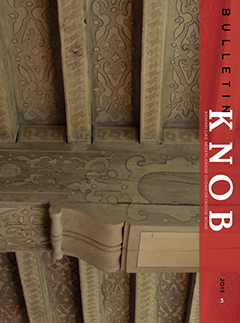Indexing ESCI / Scopus


Gabri van Tussenbroek: Inleiding. Historische houtconstructies als producten van internationale bouwmaterialenhandel Karl-Uwe Heussnner: De houtvoorziening van Amsterdam uit Scandinavië en het Baltisch gebied. Gezien vanuit dendrochronologisch perspectief (circa 1500-1700) Bernd Adam: Nederlandse houthandel op de Elbe in de zeventiende en achttiende eeuw Kristof Haneca: Historisch bouwhout uit Vlaanderen: import uit noodzaak? Dendrochronologisch onderzoek als bron voor houthandel en -gebruik Gabri van Tussenbroek: ‘De droechste waegescotten, die ghij weet te becomen’. De gedifferentieerde houtmarkt voor 1800 en de wisselwerking tussen aanbod, vraag en toepassing Dirk J. de Vries: Uit ander hout gesneden. Veranderend houtgebruik in de zestiende en zeventiende eeuw.
Met dit themanummer van het Bulletin knob wordt een aanzet gegeven om hout in historische gebouwen te beschouwen in relatie tot de internationale bouwmaterialenhandel, met het doel het onderzoek naar houtconstructies een nieuwe impuls te geven door deze binnen het theoretisch kader van internationale vraag- en aanbodmechanismes te beschouwen. De toepassing van hout was het resultaat van een complex samenspel van productie- en exploitatiemogelijkheden, behoeftes en handelspolitiek. Hoe gespecialiseerd en gedifferentieerd de markt was, blijkt uit archiefgegevens en dendrochronologisch...
Not long after the Brandenburg timber port relocated from Hamburg to Harburg in 1661, there developed a brisk trade with the Dutch market, which really took off after 1664, when the first Dutch timber merchant set up business there. Whereas Harburg had initially supplied timber for shipbuilding and coopering, there now was a significant increase in the trade in construction timber. By around 1680 there were several Dutch merchants active in the timber trade here, who mostly did their own timber buying upriver and transported the logs to Harburg with their own rafts. This practice...
In Flanders, large-scale exploitation of the landscape was initiated in the tenth century by abbeys and by powerful landowners like the Count of Flanders. As a consequence, a lot of forested areas were converted into arable land and the remaining forest and woodlands became highly fragmented. It is estimated that in Flanders the lowest forest cover ever was reached by the end of the thirteenth century. It is known that from the thirteenth century onwards, Flemish towns imported massive amounts of construction timber. However, the wholesale depletion of local forests and the associated...
Wainscoting was just one of the many products for sale on the Dutch timber market. A variety of sources would suggest that this was not primarily a case of thin, quartersawn oak planks around one centimetre thick, but much thicker, quarter-split, semi-finished products that were only later sawn into much thinner planks. A major reason for quarter sawing or splitting of logs was to mitigate warping. Finishings in particular required timber with a minimal tendency to split or bow and so wainscoting was often used for such work.
There are several views on the etymology of the word...
Long before the large-scale import of Scandinavian softwoods in the seventeenth century, deal floorboards and softwood rafters had already made their appearance before1500 and continued to appear sporadically throughout the sixteenth century, especially in cities situated on or close to the sea. The boards in that period were quite substantial: 30-50 centimetres wide and 2.7 centimetres thick. With the supply of oak via the occupied eastern and southern parts of the country wholly or partially halted during the Eighty Years’ War, alternatives were sought and were found primarily in...
Amsterdam experienced the greatest upturn in its economic fortunes in the sixteenth and seventeenth centuries. This went hand in hand with brisk building activity throughout the city. As part of studies into construction history, 679 samples of wood were subjected to dendrochronological examination. Since Amsterdam very swiftly exhausted local wood supplies, the city had to rely on importing wood to cover its immense needs. On the basis of the dendrochronologically defined samples, this article not only presents the individual datings, but also attempts to analyze the timber trade in the...
Review of a book written by Michiel Kruienier and Paul Smeets
Review on a book written by René de Kam, Frans Kipp and Daan Claessen
